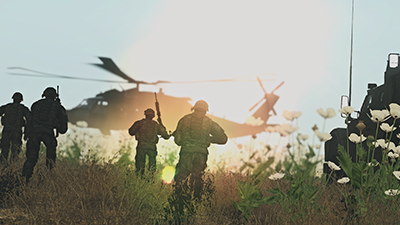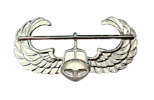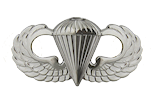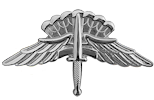The Airborne School

Introduction
The Airborne School (TAS) is a 1st Battalion (Arma 3) School operated as part of S7 - Training, Headquarters and Headquarters Company, 1st Battalion. The Airborne School instructs Soldiers on all manner of Airborne, Airmobile, and Air Assault Operations. Most TAS Courses focus on Soldier-level skills, but the School also conducts leadership training for Airborne Leaders. The School is designated the Functional Center of Excellence (FCoE) for all Airborne, Airmobile, and Air Assault doctrine, tactics, and training. Instructors at The Airborne School, known as "Black Hats" for their black baseball caps, are authorized to wear the Master Army Parachutist Badge as fully-qualified Instructors.
The Airborne School was designated in 2018 following the re-alignment of special schools. The former Combat Applications Group Parachute Company (Para Co) was disbanded, and its staff reassigned to the newly formed Airborne School. The School of Infantry also transferred responsibility for Air Assault to TAS in March 2018.
Mission and Vision
The Mission of the Cavalry School is listed as: Airborne School will train and develop the next generation of Airborne Paratroopers through the delivery of high intensity, realistic and demanding airborne training. The Airborne School will prepare Paratroopers for war by imparting the espirit de corps of the Paratrooper, forged by history and through hard-won victories of past. The Airborne School will emphasize mission command, imparting on each Paratrooper that they are a critical link in the chaos of dispersed operations.
The Vision of the School is listed as: The Airborne School is the Functional Center of Excellence (FCoE) for all Airborne operations, including the delivery of Air-Assault, Airborne, and Air-mobile training to the Combined Arms Battalion. Instructors of the Airborne school maintain the espirit de corps of the Airborne branch, through the distinctive identity and heritage of the Paratrooper. The School contributes to the lethality of the Combined Arms Battalion by providing Paratroopers who are highly trained and able to execute surprise offensive operations in the enemy's rear area at a moments notice. The School maintains expertise in all sling-load, air transport and air-to-ground communications, by training the next generation of Jump Masters and leaders in the Airborne community.
Current Courses

The Airborne School currently offers four courses: the Basic Airborne Course (BAC), Basic Air Assault Course (BAAC), the Jump-Master Course (JMC), and the Military Freefall Parachutist Course (MFFP).
Basic Airborne Course (BAC)
The Basic Airborne Course, commonly known as Airborne School or Jump School is a foundational class training Soldiers on the operation of the T-10 and T-11 Parachute in static line operations. Soldiers are trained on the basic commands for drills inside the aircraft, procedures for exiting, and actions on landing, including obstacles and hazards. Students execute jumps primarily from the C-130J Hercules Transport Aircraft, but may also jump from the CH-46 or UH-60 Helicopter. Troopers practice these skills in day and night evolutions, including a Field-Training exercise simulating combat once a Paratrooper lands. The course is 2 hours long, conducted in one day. Students who successfully complete BAC are awarded the Army Parachutist Badge.
| Pre-Requisites |
| Basic Land Navigation |
| Basic Individual Training |
| Basic Radio Communication Course |
Pre-Requisite Exemption
11B MOS Soldiers in Charlie Company applying to BAC are exempt from the following pre-requisite courses:
| Pre-Requisite Exemptions |
| Basic Land Navigation |
| Basic Individual Training |
| Basic Radio Communication Course |
Basic Air Assault Course (BAAC)
The Basic Air Assault course, commonly known as Air Assault, or Air Assault School is a foundational level class training Soldiers on the application of Air Assault tactics for use as part of an Air Assault Task Force (AATF). Soldiers are trained on commands used for boarding, and disembarking a helicopter. Students also learn the different techniques for dismounting, including formations. The course focuses on practical application, including a Field-Training Exercise simulating an Air Assault mission. The course is 2 hours long, conducted in one day. Students who successfully complete BAAC are awarded the Air Assault Badge.
| Pre-Requisites |
| Basic Land Navigation |
| Basic Individual Training |
| Basic Radio Communication Course |
Pre-Requisite Exemption
11B MOS Soldiers in Charlie Company applying to BAAC are exempt from the following pre-requisite courses:
| Pre-Requisite Exemptions |
| Basic Land Navigation |
| Basic Individual Training |
| Basic Radio Communication Course |
Jump Master Course (JMC)
The Jump Master Course, also known as Jump Master School or JM School is an advanced leadership course conducted by The Airborne School to qualify Army leaders as Jump Masters, and Drop-Zone safety officers in support of Airborne operations. Students learn how to properly site, mark, and control a Drop-Zone. Students also learn how to give briefs related to Airborne operations. The course is 2 hours long, conducted over 1 day. Soldiers who successfully qualify as Jump Masters are authorized to wear the Senior Army Parachutist Badge.
| Pre-Requisites |
| Basic Land Navigation |
| Basic Individual Training |
| Basic Radio Communication Course |
| Advanced Individual Training |
| Basic Leader Course |
| Basic Airborne Course |
Military Freefall Parachutist Course (MFFP)
The Military Freefall Parachutist Course (MFFP), commonly known as "Free-Fall" or "HALO", is a specialized course that instructs experienced Army Parachutists to conduct High Altitude, Low Opening (HALO), and High Altitude, High Opening (HAHO) parachute operations. Students for MFFP are commonly Jump Masters, Reconnaissance Soldiers or members who have completed Ranger School. Similar to BAC, students learn the basic commands associated with free-fall parachuting. They also learn about the equipment required, and how to designate release points for HALO or HAHO operations. The course takes 2 hours, and is delivered in 1 day. Students who successfully complete MFFP are awarded the Military Freefall Parachutist Badge.
| Pre-Requisites |
| Basic Land Navigation |
| Basic Individual Training |
| Basic Radio Communication Course |
| Advanced Individual Training |
| Basic Leader Course |
| Advanced Leader Course |
| Basic Airborne Course |
| Jumpmaster Course |
Awards and Decorations
The Airborne School is authorized to award several unique badges and devices for completion of their specialized courses.
| Ribbon/Award | Name | Description |

|
Air Assault Badge | The Air Assault Badge is awarded for successful completion of the Basic Air Assault Course |

|
Basic Parachutist Badge | The Army Parachutist Badge is awarded for Completion of the Basic Airborne Course. In addition, the Senior Army Parachutist Badge is awarded to soldiers who complete the Jump Master Course. The Master Parachutist Badge is awarded to qualified Instructors in The Airborne School. |

|
Basic MFFP Badge | The Military Freefall Parachutist Badge is awarded for successful completion of the Military Freefall Parachutist Course. The Master Military Freefall Parachutist Badge is awarded to Instructors at The Airborne School who also have completed the MFFP course. |
Course Request Form
If a soldier requires a course at a specific time or date, they may submit a request to the Airborne School at the following link:
| https://docs.google.com/forms/d/e/1FAIpQLSfQQvE3Vfn6KP3nKIsQq9PM0vmRB3_aoKg20QSuq4_XKzFOLw/viewform |
School Standard Operating Procedures
Instructor Qualification Policy
All new instructors to the school will start as assistant instructors - that is to assist others in the running of their courses. To become qualified as a full colours instructor and run their own courses the instructor must do the following:
- For Air Assault: Be Air Assault Qualified prior, attend one class as an observer, and then teach the course under supervision from a fully qualified instructor.
- For Basic Airborne: Be Airborne qualified prior to, attend one class, and complete the Jump Master Course. Must give 3 BAC Jump briefs without error.
- For Jump Master: Must be JMC qualified, and assist instruction once.
- MFFPC: Must already be MFFP qualified. Must be a qualified JMC instructor prior to attempting class. Must assist once before teaching.
Once this has been completed, and the lead instructor is happy with your performance, you are then able to run your own course, without oversight.
Guidance to Instructors
Instructors already qualified must remain current with the material and assist other instructors as required. They must remain proficient with the tools of administrating a course, namely posting and scheduling classes, posting the graduation work and recommending medals for courses that award any badge or award. Instructors should take the time to develop instructors in training, allowing them to conduct the necessary administration as training as part of the qualification process. Instructors should refer to this document for any future queries.
Guidance to TAS Commander
The TAS Commander must audit classes whenever possible to ensure the TAS standard is maintained.
Assigning a new Fully Qualified Instructor to a course
The TAS Commander is responsible for evaluating and passing Instructors in Training. Once the Instructor in Training has displayed the ability to lead that course effectively, the Commander will:
- Ensuring that the Instructor in Training is familiar with the correct graduation post and forum post formats and locations.
- Verify the Instructor in Training shows effective leadership
- Inform the Instructor in Training that they are now a fully qualified instructor.
New Instructor In-Clearance Routines
The Lead Instructor will:
- Conduct an in-person Initial Counselling Statement (ICS), and discuss:
- Minimum requirement of attending one course per month
- Discuss instructor interests to assign the correct section
- Explain the process to becoming fully qualified
- Review the S7 Wiki Page, as well your school’s Wiki page
- Review relevant information and S7 SOP’s with them
- Encourage the new Instructor to bookmark this information
- Explain the course scheduling policies
- Review the Regimental Calendar app
- Review the S7 Department - Class Posting SOP
- Review how to post a graduation announcement
- Add the Instructor to your school’s S7 Tracker
- Add the Instructor to your school’s S7 Google Drive with “Viewer” access
- Review your S7 Google Drive with the Instructor so they can find Lesson Plans
- Let the new Instructor know to look through the S7 Forums after S1 process their position announcement
- Encourage the new Instructor to bookmark and review the S7 Forums once available
- Create a new position assignment in the Position Announcements forum